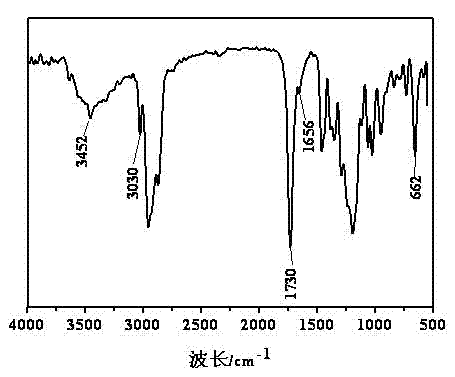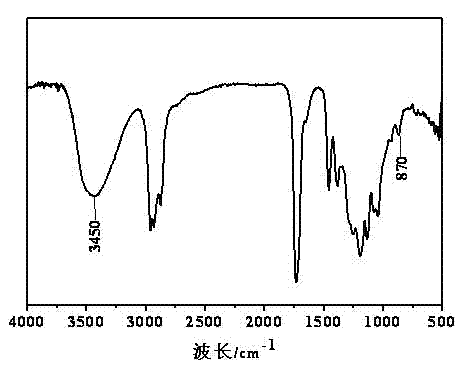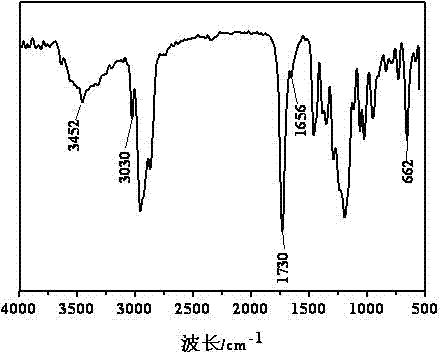Preparation method for epoxy polyester plasticizer
A technology of epoxy polyester and plasticizer, applied in the field of preparation of epoxy polyester plasticizer and epoxy polyester plasticizer, can solve the problem of poor migration resistance, material aging, polyester plasticizer Small molecular weight and other problems, to achieve good plasticizing effect
- Summary
- Abstract
- Description
- Claims
- Application Information
AI Technical Summary
Problems solved by technology
Method used
Image
Examples
Embodiment 1
[0029] (1) Esterification reaction: Add 0.20mol (30.72g) tetrahydrophthalic anhydride, 0.22mol diethylene glycol, 0.06mol isooctyl alcohol, 10mL cyclohexane, 0.30g titanic acid into a 250mL four-neck flask Tetra-n-butyl ester, nitrogen gas for 20 minutes, start stirring, slowly heat up, start timing when water comes out, keep the heating rate at 20°C / h, and the maximum temperature does not exceed 220°C, measure the acid value every 1h, the acid value The calculation refers to GB / T 1668-2008, after 5 hours of reaction, the acid value is reduced to 0.38mgKOH / g, and the esterification rate is greater than 99%. Stop heating, cool to room temperature under nitrogen, change to a vacuum distillation device, and slowly raise the temperature to 220 °C, stop heating when no liquid drops, and cool to room temperature under reduced pressure.
[0030] (2) Epoxidation reaction: Add 10g of formic acid with a mass fraction of 88% to the esterification product, stir, and heat in a water bath t...
Embodiment 2
[0032] (1) Esterification reaction: Add 0.20mol tetrahydrophthalic anhydride, 0.24mol diethylene glycol, 0.08mol isooctyl alcohol, 10mL cyclohexane, and 0.20g tetra-n-butyl titanate to a 250mL four-necked flask. , pass nitrogen gas for 20 minutes, start stirring, slowly heat up, start timing when water comes out, keep the heating rate at 20°C / h, and the maximum temperature does not exceed 220°C, measure the acid value every 1h, the calculation of the acid value refers to GB / T 1668-2008, react for 5 hours, the acid value drops to 0.35mgKOH / g, the esterification rate is greater than 99%, stop heating, cool to room temperature under nitrogen, change to a vacuum distillation device, slowly raise the temperature to 220°C, and wait until no Stop heating when the liquid drops, and cool to room temperature under reduced pressure.
[0033] (2) Epoxidation reaction: Add 15g of formic acid with a mass fraction of 88% to the esterification product, stir, and heat in a water bath to 65°C....
Embodiment 3
[0035] (1) Esterification reaction: Add 0.20mol tetrahydrophthalic anhydride, 0.26mol diethylene glycol, 0.1mol isooctyl alcohol, 10mL cyclohexane, and 0.40g tetra-n-butyl titanate to a 250mL four-necked flask. , pass nitrogen gas for 20 minutes, start stirring, slowly heat up, start timing when water comes out, keep the heating rate at 20°C / h, and the maximum temperature does not exceed 220°C, measure the acid value every 1h, the calculation of the acid value refers to GB / T 1668-2008, react for 4 hours, the acid value is reduced to 0.40mgKOH / g, the esterification rate is greater than 99%, stop heating, cool to room temperature under nitrogen, change to a vacuum distillation device, slowly heat up to 220°C, and wait for Stop heating when the liquid drops, and cool to room temperature under reduced pressure.
[0036](2) Epoxidation reaction: Add 20g of formic acid with a mass fraction of 88% to the esterification product, stir, and heat in a water bath to 70°C. After the tempe...
PUM
 Login to View More
Login to View More Abstract
Description
Claims
Application Information
 Login to View More
Login to View More - R&D
- Intellectual Property
- Life Sciences
- Materials
- Tech Scout
- Unparalleled Data Quality
- Higher Quality Content
- 60% Fewer Hallucinations
Browse by: Latest US Patents, China's latest patents, Technical Efficacy Thesaurus, Application Domain, Technology Topic, Popular Technical Reports.
© 2025 PatSnap. All rights reserved.Legal|Privacy policy|Modern Slavery Act Transparency Statement|Sitemap|About US| Contact US: help@patsnap.com



